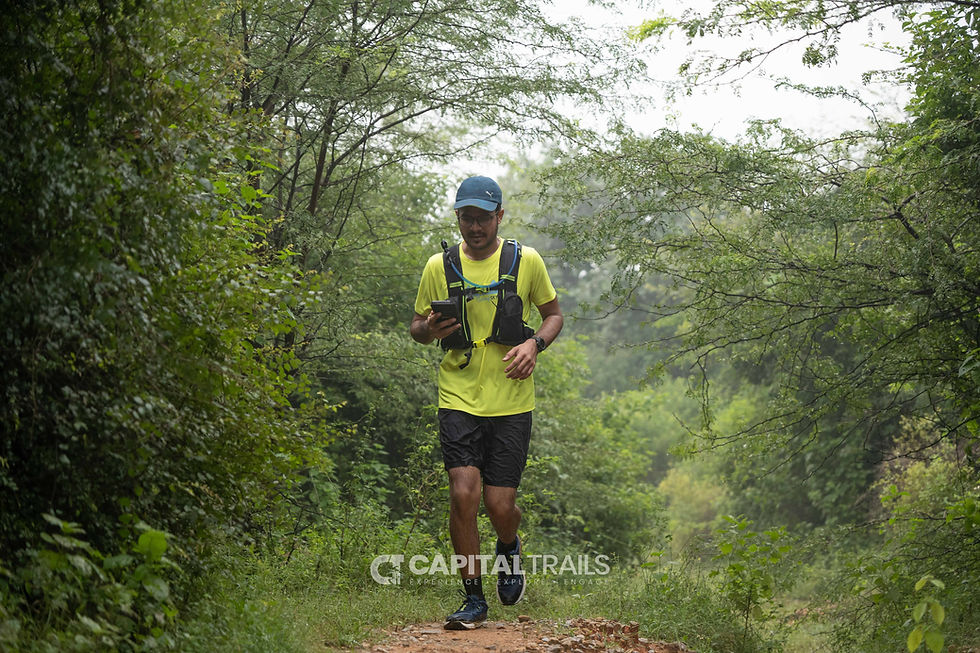Behind the Scenes of India's First 100% Self-Supported and Minimalist Trail Race
- Kshitish Purohit
- Nov 21, 2023
- 4 min read
Updated: Jul 2, 2024

September 2023 saw the first edition of India’s first and only 100% self-supported, self-navigated and self-timed minimalist trail race. Held across 10k and 20k categories, the race celebrated the true spirit of trail running by being one of the most minimalist events in the country. What does this mean? Simply put, we, at CapitalTrails, organised a community-powered race that had no route markings, aid stations, t-shirts, awards or finisher medals and had only one element - running through the trails and forests of Asola Bhatti Wildlife Sanctuary.
A truly minimalist trail race.
How It Came About
The idea to organise a race came about some time in mid-2022. After Bhatti Lakes Ultra stopped (2019 being the last edition that took place), the Indian NCR lacked a ‘true’ trail race. While there are events that are organised annually in the Gurugram Aravallis, none (barring the Red Stone Ultra race, inaugurated in 2023) have attracted or tempted serious trail runners in the region. With the NCR trails being our own little backyard, we wanted to fill that gap.
However, we didn’t want ‘just another race’.
Over the years, we have been working slowly towards building a resilient community of trail runners. We have been learning and teaching our members navigation skills, helping them use technology, educating them on various principles of the outdoors, and even organised events centred around wilderness. We wanted our race to reflect all that.
This unconventional race, thereby, sprouted from a shared passion within the CapitalTrails community, who envisioned an event where participants relied on their skills, camaraderie, and the untamed beauty of nature - and came together to celebrate the raw essence of trail running.
Race Design
Self-sufficient running is not a new concept in the world of trail running. FKTs have been attempted in self-supported or unsupported fashions for years. Self-timed races have also been popular in many local running circles in Europe and North America. We just put 2 and 2 together and brought an event with a near-zero ‘race organising’ footprint.

Here’s how it would go:
No route markings;
No aid stations;
No bibs, t-shirts, medals or awards.
And here’s how it would really go:
GPX file of the race route shared with all participants;
Volunteers at bare-minimal checkpoints for timing and checks;
Self-timing using app-based QR codes using Webscorer.
Lastly, for the community and social angle:
Have the inaugural edition only for club members;
Professional photographer for race pictures;
Plants and saplings awarded to all finishers.
Race Day
Come race day, all the runners who started pretty much started solving the navigational puzzles from the get go. While we didn’t get as many participants as expected, we were ready to cheer along even if there was just one runner on the trails.

Race day was also not without its share of drama. Despite the really low (read: minimalist) headcount, there was 1 DNS and 1 DNF due to injury. The 10k category was won by Aditya Goela in 1:04:11 while the 20k saw a photo-finish at the podium with Micah Risher bagging it in 2:30:27.
For full results, head here.
The self-supported and self-navigation perspective definitely bridged the gap between a problem solver and a fast runner. It was no longer about speed, technique or running skills. It was as much a mental effort as it was physical. In the runners’ own words and experiences, the finish line felt like a contest between who got lost more rather than who finished first.
Event Economics
Race organisation, especially in India, is mostly seen as a net out-of-pocket expense, and this perception is only exacerbated by the lack of financial sponsors and any ‘external’ funding sources in this sport. And if factors like remoteness of the event location, added expenses on insurance and rescue ops, transportation and logistics are added, trail races often remain as passion projects by runners and organisers alike. Unless there’s a scale of 700-800+ participants, the economics don’t make a lot of sense - yet on the flip side, such a high participation can potentially stress the trails a little too much.
One of the points we want to achieve via our races is ‘featherweight economics’ and keep the financial dynamics as unconventional as the race itself.

The mantra we followed was ‘eliminate, eliminate, eliminate’ and only keep what was really essential. This commitment helped us achieve a truly minimalist financial footprint as we directed all funds only towards essentials like first aid and safety measures. The only area where we went added some frills was towards hiring a professional photographer - that choice between lowering the costs and giving our participants professionally-captured Instagram moments was a tough one to make.
Our breakeven analysis put a nominal threshold of 20 registrations (10 in each category). While we couldn’t meet that number, the net ‘financial loss’ for the whole event was INR 12000 - that’s under USD 150. To put it in perspective, this is equivalent to an amount that’s less than what good races in Europe and the US charge per participation.
On the other hand, the gains we made were unbound! We're proud of what we pulled off - and even prouder of our community members who are the real heroes behind this event.
Is there a market for minimalist races? No one can tell. Will it be popular and sustainable? Again, no one can tell. What we can tell is that we’ve already planned this as a yearly race series with 3 events - one each for Delhi, Gurugram and Faridabad - our footprint is minimal but our feet are everywhere!



Comments